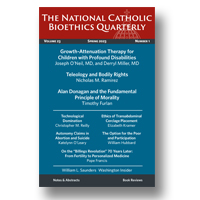|
|
|
1.
|
The National Catholic Bioethics Quarterly:
Volume >
9 >
Issue: 1
Colloquy
view |
rights & permissions
| cited by
|
|
|
|
|
|
|
2.
|
The National Catholic Bioethics Quarterly:
Volume >
9 >
Issue: 1
Edward J. Furton, M.A., Ph.D.
In This Issue
view |
rights & permissions
| cited by
|
|
|
|
|
|
|
3.
|
The National Catholic Bioethics Quarterly:
Volume >
9 >
Issue: 1
Richard M. Doerflinger
Washington Insider
view |
rights & permissions
| cited by
|
|
|
|
|
essays |
|
4.
|
The National Catholic Bioethics Quarterly:
Volume >
9 >
Issue: 1
Eugene F. Diamond, M.D.
Congenital Anomalies
view |
rights & permissions
| cited by
|
|
|
|
|
5.
|
The National Catholic Bioethics Quarterly:
Volume >
9 >
Issue: 1
John M. Travaline, M.D.
Moral Issues in Lung Transplantation Surgery
view |
rights & permissions
| cited by
|
|
|
|
|
6.
|
The National Catholic Bioethics Quarterly:
Volume >
9 >
Issue: 1
Ciarán T. Bradley, M.D.
An Ethical Appraisal of NOTES:
The Justification for Experimental Surgery
view |
rights & permissions
| cited by
|
|
|
|
|
articles |
|
7.
|
The National Catholic Bioethics Quarterly:
Volume >
9 >
Issue: 1
Bernard Farrell-Roberts
Full Facial Transplantation:
A Bioethical Study from a Catholic Perspective
view |
rights & permissions
| cited by
|
|
|
|
|
8.
|
The National Catholic Bioethics Quarterly:
Volume >
9 >
Issue: 1
Rev. Joseph C. Howard Jr.
The Principle of Double Effect as Applied to the Maltese Conjoined Twins
abstract |
view |
rights & permissions
| cited by
The principle of double effect is often used in bioethics as a tool to evaluate significant cases in obstetrics and gynecology. In this article the author, a Catholic priest, presents and interprets St. Thomas Aquinas’s delineation of the principle and discusses several classical applications, namely, to hysterectomy during pregnancy, ectopic pregnancy, and craniotomy. He explains the medical anatomy and physiology of the conjoined Maltese twins, Jodie and Mary, and then examines the arguments of four moralists on their separation. He concludes by arguing that the principle morally justified the surgical separation of Jodie and Mary. National Catholic Bioethics Quarterly 9.1 (Spring 2009): 85–96.
|
|
|
|
|
9.
|
The National Catholic Bioethics Quarterly:
Volume >
9 >
Issue: 1
Richard P. Fitzgibbons, M.D.
The Psychopathology of “Sex Reassignment” Surgery:
Assessing Its Medical, Psychological, and Ethical Appropriateness
abstract |
view |
rights & permissions
| cited by
Is it ethical to perform a surgery whose purpose is to make a male look like a female or a female to appear male? Is it medically appropriate? Sexual reassignment surgery (SRS) violates basic medical and ethical principles and is therefore not ethically or medically appropriate. (1) SRS mutilates a healthy, non-diseased body. To perform surgery on a healthy body involves unnecessary risks; therefore, SRS violates the principle primum non nocere, “first, do no harm.” (2) Candidates for SRS may believe that they are trapped in the bodies of the wrong sex and therefore desire or, more accurately, demand SRS; however, this belief is generated by a disordered perception of self. Such a fixed, irrational belief is appropriately described as a delusion. SRS, therefore, is a “category mistake”—it offers a surgical solution for psychological problems such as a failure to accept the goodness of one’s masculinity or femininity, lack of secure attachment relationships in childhood with same-sex peers or a parent, self-rejection, untreated gender identity disorder, addiction to masturbation and fantasy, poor body image, excessive anger, and severe psychopathology in a parent. (3) SRS does not accomplish what it claims to accomplish. It does not change a person’s sex; therefore, it provides no true benefit. (4) SRS is a “permanent,” effectively unchangeable, and often unsatisfying surgical attempt to change what may be only a temporary (i.e., psychotherapeutically changeable) psychological/psychiatric condition. National Catholic Bioethics Quarterly 9.1 (Spring2009): 97–125.
|
|
|
|
|
verbatim |
|
10.
|
The National Catholic Bioethics Quarterly:
Volume >
9 >
Issue: 1
Maureen L. Condic
When Does Human Life Begin?:
A Scientific Perspective
view |
rights & permissions
| cited by
|
|
|
|
|
notes & abstracts |
|
11.
|
The National Catholic Bioethics Quarterly:
Volume >
9 >
Issue: 1
Rev. Nicanor Pier Giorgio Austriaco
Science
view |
rights & permissions
| cited by
|
|
|
|
|
12.
|
The National Catholic Bioethics Quarterly:
Volume >
9 >
Issue: 1
Journals in Science
view |
rights & permissions
| cited by
|
|
|
|
|
13.
|
The National Catholic Bioethics Quarterly:
Volume >
9 >
Issue: 1
Greg F. Burke, M.D., F.A.C.P.
Medicine
view |
rights & permissions
| cited by
|
|
|
|
|
14.
|
The National Catholic Bioethics Quarterly:
Volume >
9 >
Issue: 1
Journals in Medicine
view |
rights & permissions
| cited by
|
|
|
|
|
15.
|
The National Catholic Bioethics Quarterly:
Volume >
9 >
Issue: 1
Christopher Kaczor, Ph.D.
Philosophy and Theology
view |
rights & permissions
| cited by
|
|
|
|
|
16.
|
The National Catholic Bioethics Quarterly:
Volume >
9 >
Issue: 1
Journals in Philosophy and Theology
view |
rights & permissions
| cited by
|
|
|
|
|
review essay |
|
17.
|
The National Catholic Bioethics Quarterly:
Volume >
9 >
Issue: 1
John Finnis
Human Life, Action and Ethics: Essays by G.E.M. Anscombe edited by Mary Geach and Luke Gormally
view |
rights & permissions
| cited by
|
|
|
|
|
|
|
18.
|
The National Catholic Bioethics Quarterly:
Volume >
9 >
Issue: 1
Call for Papers
view |
rights & permissions
| cited by
|
|
|
|






